
A mango is a stone fruit produced from numerous species of tropical trees belonging to the flowering plant genus Mangifera, cultivated mostly for their edible fruit. Most of these species are found in nature as wild mangoes. The genus belongs to the cashew family Anacardiaceae. Mangoes are native to South Asia, from where the "common mango" or "Indian mango", Mangifera indica, has been distributed worldwide to become one of the most widely cultivated fruits in the tropics. Other Mangifera species are grown on a more localized basis.

Mangifera is a genus of flowering plants in the cashew family, Anacardiaceae. It contains approximately 69 species, with the best-known being the Common Mango. The center of diversity is in subtropical and tropical South Asia and Southeast Asia, while the highest number of species occur in India. They are generally canopy trees in lowland rainforests, reaching a height of 30–40 m (98–131 ft).
Indica is classical Greek and Latin for "of India". It may refer to:

Mangifera caesia is a species of flowering plant in the cashew family, Anacardiaceae. Common names include jack, white mango, binjai, wani, yaa-lam, bayuno/baluno/belunok and mangga wani. It belongs to the same genus as the mango and is widely cultivated in areas of Indonesia, Malaysia, Singapore, Brunei, Papua New Guinea and the Philippines.
Aniba pedicellata is a species of plant in the family Lauraceae. It is endemic to Brazil.
Hopea pedicellata is a species of plant in the family Dipterocarpaceae. It is found in Cambodia, Indonesia, Malaysia, and Thailand.
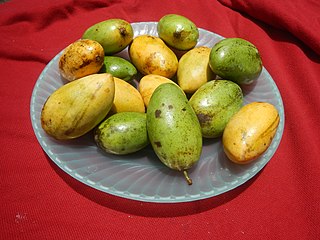
Mangifera altissima, is a species of mango native to the Philippines and surrounding regions in Indonesia, Malaysia, Papua New Guinea and the Solomon Islands. It is not grown commercially but is harvested from the wild in the Philippines. It has small fruits that are pale yellow when ripe and are very sweet, though much more fibrous than commercially cultivated Mangifera indica species like Carabao mangoes. It is threatened by habitat loss.
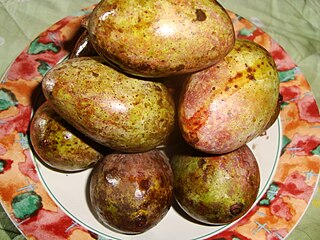
Mangifera casturi is a species of plant in the family Anacardiaceae.

Mangifera foetida is a species of plant in the family Anacardiaceae. It is found in wet-land rainforest regions of Indonesia, Malaysia, Myanmar, Singapore, Thailand, and Vietnam.

Mangifera odorata is a species of plant in the family Anacardiaceae. It is commonly found along coastal towns or travel routes in Southeast Asia. "Also found in Peninsular Thailand, South Sulawesi and in Philippines on South coast of Mindanao, in Sulu Archipelago and neighboring islands". "It is a well known fruit tree commonly cultivated in villages throughout Southeast Asia".

Mangifera pajang is a species of plant in the family Anacardiaceae. It is found only in Borneo, which comprises the Brunei sultanate, Kalimantan province of Indonesia, and the Malaysian states of Sabah and Sarawak. The fruit is known in Borneo with its native name, Bambangan.
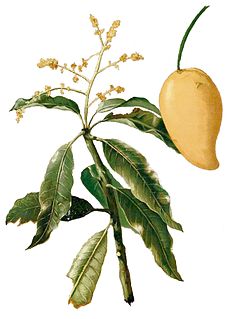
Mangifera sylvatica, also known as the Himalayan mango, pickling mango, or Nepal mango, is a species of plant in the family Anacardiaceae. It is found in Bangladesh, Cambodia, China (Yunnan), India, Myanmar, Nepal, Bhutan and Thailand. It is a tree 6–20 m (20–66 ft) tall. The fruit measure 6 cm–8 cm × 4 cm–5 cm.

Mangifera zeylanica or “Sri Lanka wild mango” is a wild species of mango tree endemic to Sri Lanka. This stately tree is the tallest member of the mango genus, Mangifera, and one of the two tallest trees in the family Anacardiaceae. The mango fruits are edible and have an excellent taste. It is called "aetamba" (ඇටඹ) or "wal amba" in Sinhala and “kaddu-ma” in Tamil. The well-known British botanist and explorer Joseph Dalton Hooker first described the tree in 1876.
Tricalysia pedicellata is a species of plant in the family Rubiaceae. It is endemic to Tanzania.
Vatica pedicellata is a species of plant in the family Dipterocarpaceae. It is a tree endemic to Borneo where it is confined to Sarawak.

Mangifera indica, commonly known as mango, is a species of flowering plant in the sumac and poison ivy family Anacardiaceae. It is native to the Indian subcontinent where it is indigenous. Hundreds of cultivated varieties have been introduced to other warm regions of the world. It is a large fruit-tree, capable of growing to a height and crown width of about 30 metres (100 ft) and trunk circumference of more than 3.7 metres (12 ft).

Crataegus coccinea, the scarlet hawthorn, is a species of hawthorn around which there is considerable confusion because the name has been misapplied for a long time. It has been shown to be the same as C. pedicellata, and under the rules of botanical nomenclature, the older name should be used.
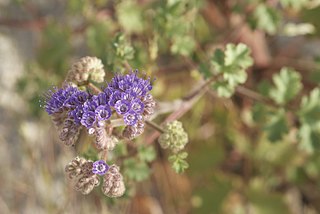
Phacelia pedicellata is a species of flowering plant in the borage family, Boraginaceae. Its common names include specter phacelia and pedicellate phacelia. It is native to the southwestern United States and Baja California, where it can be found in several types of habitat, including creosote bush scrub and Joshua tree woodland.
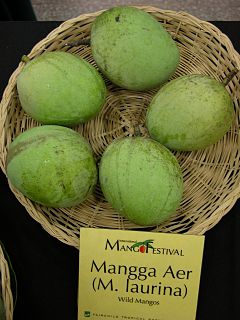
Mangifera laurina is a species of flowering plant in the family Anacardiaceae. It commonly known as mangga kopyor, mangga pari in Indonesian.

Salix pedicellata is a species of willow. It is a shrub or small tree to about 6–8 m tall, native around the Mediterranean Sea from Portugal to Lebanon and Syria in the north and from the Canary Islands to Tunisia in the south. Salix canariensis may be treated as a subspecies of S. pedicellata.















